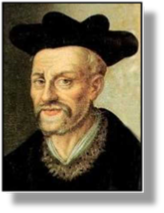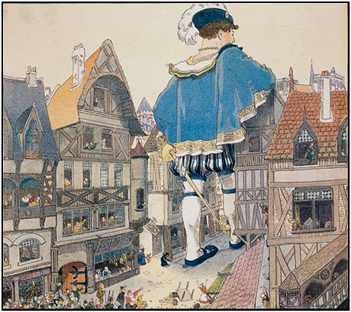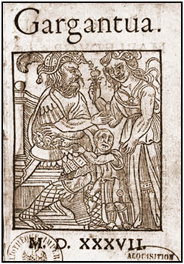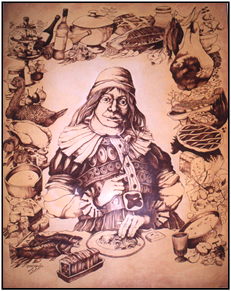


FRANÇOIS RABELAIS c1493 -
xxxxxThe French writer François Rabelais is best known for his satirical comedies, Pantagruel, the story of a young giant, and Gargantua (1534) the fantastic adventures of his equally large father. These and his other works were used to launch a blistering attack upon the shortcomings of contemporary society. Virtually no profession escaped his colourful language and ribald wit, but by such means he made a strong plea for a fairer and freer society. Not surprisingly, his books were condemned for their obscenity, but many people were delighted with them, including the king, Francis I. With his death in 1547, however, Rabelais had to make his escape from Paris and settle abroad. To this period belongs his final work, Quart Livre. He was acquainted with the French poet Joachim Du Bellay, and among writers clearly influenced by him were Laurence Sterne, Honoré de Balzac and James Joyce.
xxxxxThe French  satirical writer François Rabelais is best known for his allegories about the heroic deeds and sayings of two giants, father and son. They appear in four rumbustious works, the first two being the Heroic Deeds and Sayings of the Great Pantagruel, published in 1532, and The Inestimable Life of the Great Gargantua, produced two years later in 1534. He completed his third book, Tiers Livre in 1546, and his fourth and final work, Quart Livre, appeared in 1552. The books are not in sequence -
satirical writer François Rabelais is best known for his allegories about the heroic deeds and sayings of two giants, father and son. They appear in four rumbustious works, the first two being the Heroic Deeds and Sayings of the Great Pantagruel, published in 1532, and The Inestimable Life of the Great Gargantua, produced two years later in 1534. He completed his third book, Tiers Livre in 1546, and his fourth and final work, Quart Livre, appeared in 1552. The books are not in sequence -
xxxxxRabelais was born in Chinon, Touraine.  He was educated for the Church and is known to have been a Franciscan and a Benedictine monk. He then went on to study medicine at the University of Montpellier and practised in Narbonne for a short time before taking up a hospital appointment in Lyon. He proved to be a competent physician and, throughout his active life, lectured and wrote on medical subjects. It was during his time at Lyon, however, that he found his true vocation as a writer of comedy and satire. His first major work, Pantagruel, tells the story of a young powerful giant, overflowing with a lust for life -
He was educated for the Church and is known to have been a Franciscan and a Benedictine monk. He then went on to study medicine at the University of Montpellier and practised in Narbonne for a short time before taking up a hospital appointment in Lyon. He proved to be a competent physician and, throughout his active life, lectured and wrote on medical subjects. It was during his time at Lyon, however, that he found his true vocation as a writer of comedy and satire. His first major work, Pantagruel, tells the story of a young powerful giant, overflowing with a lust for life -
xxxxxBoth books, published under the  thinly disguised nom-
thinly disguised nom-
xxxxxThat this vast, jumble of works should cause  concern amongst the establishment is hardly surprising. Like the English satirist Jonathan Swift (yet to come), he was a brilliant, highly intelligent writer who, armed with a scathing wit and a keen social and political insight, launched a blistering attack upon the weaknesses of contemporary society. Virtually no profession escaped his satirical and critical attention, but monks, lawyers, physicians, pedagogues and politicians came in for the worst of his ribald and colourful language. But it is not all destructive criticism. From out of this fantasy world, full of legends and romances, emerges a search for knowledge and its application. In Pantagruel, for example, he sets out to describe his own idea of Utopia -
concern amongst the establishment is hardly surprising. Like the English satirist Jonathan Swift (yet to come), he was a brilliant, highly intelligent writer who, armed with a scathing wit and a keen social and political insight, launched a blistering attack upon the weaknesses of contemporary society. Virtually no profession escaped his satirical and critical attention, but monks, lawyers, physicians, pedagogues and politicians came in for the worst of his ribald and colourful language. But it is not all destructive criticism. From out of this fantasy world, full of legends and romances, emerges a search for knowledge and its application. In Pantagruel, for example, he sets out to describe his own idea of Utopia -
xxxxxIn the intolerant times in which he lived, Rabelais only managed to escape imprisonment or worse because of the king’s support up to 1547, and the close, influential friends he managed to keep around him. Among these “protectors” were the cardinal and diplomat Jean du Bellay, with whom he travelled to Italy three times, and his brother, the poet Joachim du Bellay.
xxxxxIncidentally, the adjective “gargantuan” is still used today to imply something of giant size, and the word Rabelaisian now describes any piece of satire which is coarse or downright obscene. Among writers who were clearly influenced by Rabelais -



Acknowledgements
Rabelais: 17th century, artist unknown – National Museum, Palace of Versailles, France. Gargantua: illustration by the engraver Adrian Leroy for the 1913 edition of The Inestimable Life of the Great Gargantua – National Library of France, Paris.
H8-